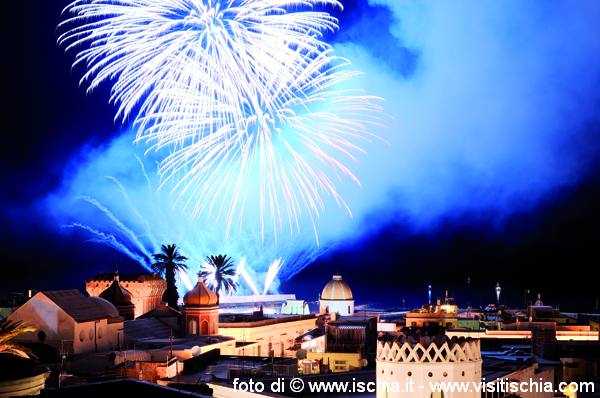St. Vito at the time of the Grand Tour

The following article is a summary from the book “Souvenirs of Ischia” published in French in 1886 and is contained in the book by Giovanni Castagna on “French travelers to discover Ischia” at the time of the “Grand Tour” (XIX century).
The author is abbot Alphonse Kannengiesser of Rixheim (Haut Rhin), who spent several months in 1883 on the island of Ischia as a tutor in the family of Bernardo Blumenstihl, director of the aqueduct Marcia di Roma.
The family was staying at the Villa Giuochi in Casamicciola, located where the “Principessa Margherita road intersects that one of Garibaldi to the left” as stated Dr. Andrea Giuochi, owner of the Villa, in his book “Ischia dalla sua origine fino ai nostri giorni” in 1884. At Villa Giuochi the whole Blumenstihl family stayed except Mr. Bernardo, for the care of his daughter Mary. In the earthquake of July 28, 1883 died the wife of Bernard, Giustina and little Mary, while were saved the preceptor and the other two children of Bernardo, Paolo and Emilio, students of the abbot. Abbot Kannengiesser collected his souvenirs mostly made of a series of letters to friends and acquaintances in the book of memories. The article describes a trip in Forio on the day of the St. Vito celebrations. The fresco of Forio, its landscapes and its colors, its people and its traditions, is a “timeless island”, as, a little less than a century after, Truman Capote described it.
Giuseppe Mazzella
I continue my explorations through Ischia. Lately I went to visit Forio, the most notable district of the island. It is a large village of about 7000 inhabitants, situated in the West, at the foot of Epomeo near the sea. The hike was beautiful and I always kept the memory alive. The road that leads to Forio crosses picturesque sites that we would look in vain in other parts of the island. When one has visited Ischia with its castle and its lava field, when one took on some high ground around where the view embraces the magnificent horizon of the Gulf of Naples, contemplated from the top of a hill the village of Casamicciola with its hotels and villas that boast their dazzling plaster among orange groves, it is possible imagine that any further hike would only detract from the first impressions. But the peculiarity of the island of Ischia is to reserve continually new surprises. I made the sweet experience going to Forio.
There Forio. In the distance you can see its many churches, its crenellated towers of the Middle Ages, the houses with flat roofs and semi-desert harbor. From this part of the island, Mount Epomeo is visible much less that above Casamicciola. The vineyards rise up to the mouth of the crater of the volcano. The orange and the fig tree, while not completely disappear, give way to the vine that is cultivated with great care producing wine much appreciated.
I really chose well the day of my visit to Forio. An immense crowd of islanders had gathered there: it was celebrating with great pomp the feast of St. Vito, the patron saint of the city. All the streets were decorated: many wreaths adorned the houses and the image of the saint was suspended at the entrance of the main streets. We do not have any idea of the enthusiasm that animates these people full of faith when they celebrate religious holidays. The feast of Santa Restituta in Lacco and San Vito in Forio are really beautiful. In Forio the turnout was extraordinary. It was rather difficult to circulate among the crowd of people in the streets. I speak of roads; to be more precise I should replace this noun with ‘alley’. In this town, in fact, with something of east, the more spacious roads are just three meters wide. The view of the dense crowd in these narrow corridors was even more impressive. The islanders had put on their finest clothes. I should have the treasure chest of an imaginary poet to paint the effects of light and perspective from all those colorful costumes that I had before my eyes.
The dress has noteworthy particulars. The women get her hair wrapped in a silk handkerchief which falls nicely on the shoulders or around the head-shaped turban. From her ears hanging gold earrings, the little ones are 12 to 15 centimeters long. A dress without ornaments, a tunic tight at the waist, a pair of elegant sandals, and, for richer, three or four chains of precious metal suspended from the neck form the gala dress of the “Ischiote”. But what distinguishes this dress, apparently totally insignificant, is the diversity of the colors of the individual garments that make it up. Women of Ischia, as I said, love to combine together the colors to create amazing contrast. One will combine her shawl with yellow-orange and purple red of her robe, and her Polish will be as white as snow. Another one will give preference to dark green to blue to violet. The entire rainbow is used. Iris personified in a whole people. And what freshness, splendor in these colors! They seem characters of a fresco by Fra Angelico descending from the ceiling of a cathedral to walk in procession through the streets of Forio. Any clothing, considered separately, is so alien to our tradition that it is hard not to consider it baroque.
The decoration of the church follows the same rules as the clothing needed to ascertain coming to San Vito. But to reach the shrine, we had to first get out of the ever-growing crowd which occupied the entire width of the street. It proceeded slowly. My French dress and the presence of my two students with their glasses aroused the curiosity of those good islanders. Hundreds of eyes were constantly fixed on us and I had the opportunity to study the types and expressions on their faces. That entire crowd that was waving around us was cheerful and happy. The girls were walking in groups and demonstrated a certain coquetry in gait, in demeanor and in attitude. Most of the men had a hat decorated with artificial flowers as conscripts in our country. The wealthy men wore a large multi-colored tie that struck the eye, their frowning made me understand that they were the owners of several parcels of vineyards and the haughty air that flaunted confirmed my conjecture. Only the old sailors and fishermen replaced the red cap of the hat, a too modern invention.
They talked loudly, laughed, hugged exchanging greetings in contemplating the evening procession. Everything took place in a very decent way: I was in Forio around six in the evening and I had not seen anyone who was quite drunk. From time to time a passerby was trying to show off honoring a delightful greeting. At the turn of a street, a nice Franciscan friar with radiant face came to me with his best smile to kiss my hand. I was so astonished by this gesture of affection that I could not even respond to his “Excellency, I kiss your hand!” Later we meet a group of guys with white trousers and red jackets with golden edges. By their presence, these lovely cherubs were supposed to emphasize the beauty of the procession that took place after the ceremonies of the evening. As you can imagine, a great feast for the eyes and the heart. And also for our backs, on the other hand, because every moment I was struck by a priest in surplice and biretta rushing towards the church, such as municipal employee who looked after the order and the instrument of a musician who ran to the appointment of the band. After many vicissitudes, finally, we come to San Vito. Outside the church has a rather drab aspect but what luxury inside! Also, the work of the king is adorned with the most beautiful of his robe. Wallpaper purple, cloth of gold and silver covering the walls from top to bottom of the building.
The altars are hidden under the bundles of flowers; the courtyard of the shrine is strewn with leaves of myrtle. And the people are there to feed the imagination with that entire splendor ... perhaps hardly conform to the canons of aesthetics! But everything glows in the sun, what does philosophy for? Forward, however, we expect mainly nighttime lighting that is being completed with great alacrity. Thousands of street lights adorn the facade of the church: on the square near there are large-scale fireworks. This esplanade overlooking part of the city, the mountains and the sea and beyond the countless flames that light up the night and sparkle to any place, will offer the most impressive of shows. Even more difficult to satisfy the taste will not find anything to criticize about this part of the party, because the lighting in Forio, Lacco, Casamicciola and Ischia are stunning. And all these expenses, my dear friend, are made in honor of God and the Saints. This thought fills me with joy and inspires me a lively sympathy for the good people of the island of Ischia. Reading my letter, you will perhaps share my benevolent provisions in respect of them. In any case, it will show an interesting side of the religious character of these people and you will be forced to tell what I said to myself while I left Forio: “The Catholic faith still has deep roots in this small island in the Gulf of Naples”.










































